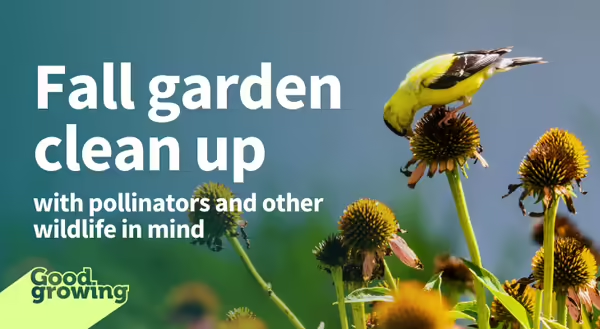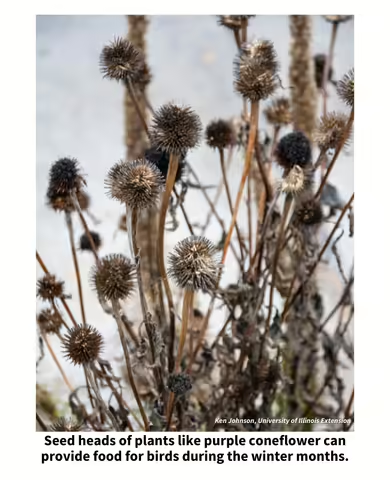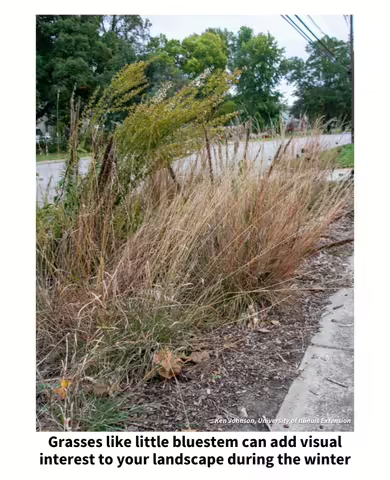
As the days get shorter and cooler, the gardening season starts to wind down, and many of us will begin cleaning up our landscapes for the winter. While cutting back dead plants and raking leaves can make for a clean-looking yard, it may not be the best thing for pollinators and other wildlife that inhabit our landscapes. So, how should we approach garden clean-up in the fall?
How do pollinators and other wildlife overwinter?
While monarchs and some species of birds will migrate south for the winter, most of our pollinators and other wildlife will stick around. Most insects will enter diapause (they stop developing due to unfavorable conditions) during the winter months. Depending on the species, this can be as an egg, larva, pupa, or adult. Regardless of what development stage they spend the winter in, insects will seek out protected locations to spend the winter.
Amphibians will enter go into hibernation (actually brumation) to spend the winter. Some, like salamanders and toads, will burrow into the ground and try to stay below the freeze line. Peepers and wood frogs may also burrow into the soil to overwinter, but not as deeply. They will be subject to freezing temperatures and will produce an “antifreeze” to prevent their cells from freezing, but the rest of their bodies will freeze.
What should I do with my leaves?
Fallen leaves can be an excellent place for insects and other wildlife to overwinter. These leaves provide a protected location. Many species of moths and butterflies like swallowtails and luna moths will overwinter in leaves. Bumble bee queens may also utilize leaves to overwinter in.
Fallen leaves can also provide insulation for those animals overwintering in the ground. A good example of this is with spring peepers; if peepers get too cold, they will die. Having a layer of leaves can help protect these frogs and may make a difference in their ability to survive.
Leaves in lawns are commonly raked up and then bagged to be taken away or burned. Instead of getting rid of your leaves, consider leaving at least some of them where they are (it doesn’t need to be your entire landscape). Leaving leaves in garden beds or out-of-the-way areas will provide habitat for overwintering animals.
One common concern with fallen leaves is that they will smoother and kill turfgrass. This is certainly true if you have a thick layer of leaves on your lawn. However, if only 10-20% of your lawn is covered in leaves, they can be left where they are since they are unlikely to smother turf. If more of your yard is covered, you can rake the leaves from your lawn into garden beds or other areas of your property where they can serve as a mulch and break down over time.
Alternatively, leaves in your lawn can be mowed over and mulched into your turf. This will help return nutrients back into the soil and build organic matter. Don’t let the leaves build up too much if you go this route, or they may not work their way down through the turf. You may need to mow several times if you have a lot of leaves on your lawn. However, mowing and mulching leaves may negatively impact wildlife that may be utilizing the leaves to overwinter.
Cleaning up perennial and annual plants
Once our perennial plants begin to decline in the fall, many of us will go out and remove flower stalks and dead foliage, giving our landscapes a nice, tidy appearance. While this may be visually appealing to some, it’s not the best habitat for wildlife during the winter.
Instead of cutting down dead plant material this fall, wait to remove it until the spring and embrace its beauty this winter. Leaving flower stalks, dead/dried leaves, and grasses stand can add dimension and visual interest to a landscape.
This dead plant material can also be habitat for pollinators and other beneficial insects. Some of these insects may lay their eggs on these plants. Many butterflies will also pupate and spend the winter on these plants as well. By leaving this plant material in the landscape, we can preserve these insects for next year.
Leaving flower stalks in your landscape can also benefit birds. The seed heads of plants like black-eyed Susan, sedums, purple coneflowers, Joe-Pye weed, and marigolds can be an important food source for seed eating birds, like finches, during the winter. Additionally, insects that overwinter on these plants will provide food for these birds’ babies in the spring.
An additional benefit to letting this dead plant material stand during the winter is that they will catch leaves. These leaves can provide some extra insulation for the plants.
If you feel like you need to cut back your plant material, keep it in your landscape instead of getting rid of it. If you remove flower stalks, bundle them up and put them in an out-of-the-way area. Some native bee species like small carpenter, mason, and leaf-cutter bees may utilize these hollow stems as nesting habitat.
One exception to waiting to clean up flower beds is if you’ve had issues with diseases (more than the occasional leaf spot). Often these organisms will overwinter on plant debris, so cleaning up diseased plant material can help reduce problems with them next year.
What about vegetable gardens?
Vegetable gardens are another area where you want to do a good job with garden clean-up, especially if you’ve had pest and disease issues. Like beneficial insects, pest insects, like squash bugs, and diseases will overwinter in plant debris. Removing plant debris can help reduce the amount of pest and disease issues you may encounter in your garden next year.
Controlling weeds in vegetable gardens is also a good idea. Winter annual weeds like henbit, common chickweed, and shepherd’s purse will germinate in the fall and resume growth in spring. Managing them now may lead to fewer weed problems in the spring, at least until summer annual weeds start germinating.
Instead of being in a hurry to clean up, channel your inner procrastinator and enjoy the changing seasons. The things you "need’ to clean up will still be there come spring.
Good Growing Tip of the Week: When using leaves as mulch, make sure to leave some bare patches of ground. Around 70% of native bee species nest in the ground; if we mulch everything, there won’t be anywhere for them to build their nests come spring.
Want to get notified when new Good Growing posts are available? SIGN UP HERE!
Give us feedback! How helpful was this information (click one): Very helpful | Somewhat helpful | Not very helpful
MEET THE AUTHOR
Ken Johnson is a Horticulture Educator with University of Illinois Extension, serving Calhoun, Cass, Greene, Morgan, and Scott counties since 2013. Ken provides horticulture programming with an emphasis on fruit and vegetable production, pest management, and beneficial insects. Through his programming, he aims to increase backyard food production and foster a greater appreciation of insects.

